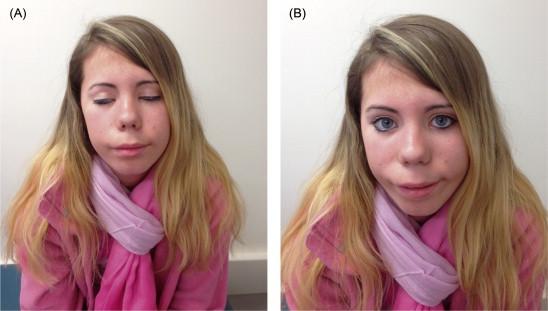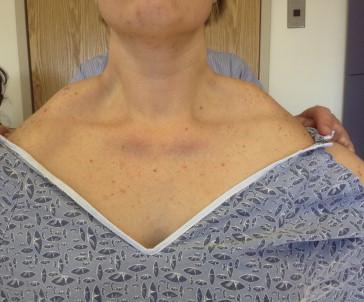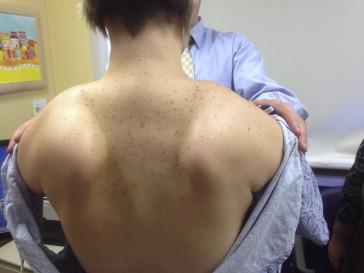Physical Address
304 North Cardinal St.
Dorchester Center, MA 02124
Facioscapulohumeral muscular dystrophy (FSHD) is the third most common muscular dystrophy after dystrophinopathies and myotonic muscular dystrophy. It affects 1 in 15,000 to 20,000 individuals with an estimated prevalence of 4 to 7 per 100,000. FSHD was first described by Landouzy and Dejerine in 1884. A study in 1952 looking at six generations of a single family from Utah further described the clinical manifestations of FSHD.
FSHD is a slowly progressive form of muscular dystrophy with an autosomal dominant inheritance in most cases that is caused by a contraction of the macrosatellite repeat array D4Z4 in the subtelomere of chromosome 4q (FSHD1). In approximately 5% of patients with FSHD (FSHD2), there is no contracted D4Z4 repeat array in chromosome 4, but these patients most often have a mutation in SMCHD1 . Although these two forms of FSHD, FSHD1 and FSHD2, are genetically distinct, they are identical in their clinical presentation and disease progression. The age of onset is variable with a 95% penetrance by the age of 20.
Diagnostic criteria were first developed by the Facioscapulohumeral Consortium at the International Conference on the Cause and Treatment of FSHD in 1997 ( Box 32.1 ). Following that, similar diagnostic criteria were formulated by a European Neuromuscular Centre workshop. These clinical diagnostic criteria for FSHD are now superseded by molecular genetic testing since diagnostic DNA testing for the D4Z4 contraction on chromosome 4q is readily available.
Weakness of face or scapular stabilizers (in familial cases, facial weakness is present in >90% of affected individuals)
Scapular stabilizer weakness greater than hip-girdle weakness (applicable in mild to moderate cases)
Autosomal dominant inheritance in familial cases
Extraocular or pharyngeal muscle weakness
Prominent and diffuse elbow contractures
Cardiomyopathy
Distal symmetrical sensory loss
Dermatomyositic rash or signs of an alternative diagnosis
Electromyographic evidence of myotonia or neurogenic potentials
Asymmetry of muscle weakness
Descending sequence of involvement
Early, often partial, abdominal muscle weakness (positive Beevor’s sign)
Sparing of deltoid muscles
Typical shoulder profile: straight clavicles, forward sloping of shoulders
Relative sparing of neck flexors
Selective weakness of wrist extensors in distal upper extremities
Sparing of calf muscles
High-frequency hearing loss
Retinal vasculopathy
Patients with FSHD classically present with asymmetric weakness in the face, shoulders, limb girdle, and abdomen. There is a selective sparing of the masticatory, lingual, and extraocular muscles in the facial weakness. Progression of disease is slow and there is a variable spectrum of disease severity. Some individuals remain asymptomatic or minimally symptomatic throughout their lives, with 20% of patients becoming wheelchair dependent and significantly disabled. There are reports that suggest that several factors may affect the prognosis and clinical severity of FSHD. Women appear to be less affected compared to men, although this was not noted in patients with FSHD2. Severely affected cases also seem to originate more often through new mutations or more commonly transmitted through maternal than through paternal lines. Some reports suggest that there may also be an element of clinical anticipation in FSHD, which predicts increasing severity with each subsequent generation; however, this was not confirmed by subsequent studies.
The initial manifestation in the majority of patients is asymptomatic facial weakness affecting the orbicularis oculi and orbicularis oris. Later on, difficulty in eye closure ( Figure 32.1A ) and the inability to smile, whistle, drink from a straw, or blow up balloons is noted. Patients also develop pouting of the lips (bouche de tapir), a relatively expressionless face, and the characteristic dimpling lateral to the angles of the mouth, which become deeper when the patient smiles or tries to bare the teeth ( Figure 32.1B ). The onset is usually insidious, with a slow progression of muscle weakness involving the scapular fixators (latissimus dorsi, lower trapezius, rhomboids, and serratus anterior), humeral, truncal, and lower extremities.

Weakness of scapular fixators together with the atrophic sternocostal head of the pectoralis major muscles results in an upward slope of the axillary folds. The deltoid muscles are relatively spared early on in the disease; even as the disease progresses, they are less affected compared to the other shoulder girdle muscles. This gives the “humeral” appearance seen in FSHD. Patients typically report difficulty in raising their arms. When arm abduction is attempted, the scapulae ride upwards and over the trapezius, resulting in a hypertrophic appearance ( Figure 32.2 ). Scapular winging is a common feature. In the early stages, scapular winging can be made more apparent with the abduction and forward movement of the arms ( Figure 32.3 ). Patients can be asked to push against the wall, which activates the serratus anterior and brings out the scapular winging. While the supraspinatus and infraspinatus muscles are still preserved early on in the disease process, patients have little difficulty abducting their arms up to approximately 25 degrees, as this movement utilizes the supraspinatus muscle. Mechanically fixing the scapula in place allows the spared deltoid muscles to complete the remaining abduction movement to the horizontal position. Abduction of the arm beyond that requires rotation and fixation of the scapula to the chest wall.


Truncal and abdominal wall weakness results in the lumbar lordosis and protuberant abdomen commonly seen in patients with FSHD. The upper abdominal wall muscles, which are usually stronger than those of the lower abdominal wall, cause an upward movement of the umbilicus during neck flexion in a patient lying in a supine position. This is called the Beevor’s sign and is fairly specific for FSHD. In a prospective case-control study, the Beevor’s sign was found in 90% of FSHD patients.
The peroneal muscles are often affected in FSHD, resulting in foot drop. Mild tendon contractures and pseudohypertrophy of the muscles, particularly the extensor digitorum brevis, may be present. In contrast, severe contractures are usually not found. In advanced stages of the disease, the hip girdle muscles may also be affected, in some cases more so than the shoulder girdle muscles. For patients presenting only in this late stage of the disease, it may be difficult to make a clinical distinction between FSHD and limb girdle muscular dystrophy.
Involvement of other systems is reported in FSHD. These include hearing loss, retinal disease, cardiac arrhythmia, cognitive impairment, and seizures. Sensorineural hearing loss is described in both infantile and typical FSHD patients. Screening audiometry is abnormal in up to 75% of affected individuals, and initially presents as high-frequency hearing loss with progression to involvement of all frequencies. In some patients, FSHD-associated hearing loss can remain stable over long periods of time. Symptomatic hearing loss, however, is seen almost exclusively in patients with large D4Z4 deletions.
Minimal retinal vascular abnormalities are seen in 50% to 75% of patients. Capillary telangiectasia, microaneurysms, capillary closure, and protein exudation have been described. In rare cases, retinal detachment and visual loss (Coat’s syndrome) can occur. In a study performed by Fitzsimons et al., 56 out of 75 patients with a molecular diagnosis of FSHD had evidence of retinal capillary abnormalities as demonstrated by fluorescein angiography. In some of these patients, the retinal vascular disease seems to have developed early, even before any overt muscle weakness was present. Photocoagulation of capillary telangiectasia, if done early, may be effective in preventing progression to Coats’ syndrome. There does not appear to be any clear association between the extent of the retinal vasculopathy and the severity of the myopathy. As in hearing loss, retinal vasculopathy is largely asymptomatic except in patients with very large D4Z4 deletions.
Minimally symptomatic or asymptomatic cardiac arrhythmias, specifically atrial arrhythmias, are reported in approximately 5% of patients. Generally, symptomatic respiratory compromise in FSHD is rare, with evidence of restrictive lung disease on pulmonary function testing in about 10% of patients. In a study of FSHD patients in the Dutch population, respiratory insufficiency requiring ventilatory support was seen in 1% of their patients. These patients were typically wheelchair dependent and had severe scoliosis and lumbar lordosis. Cognitive impairment and seizures are rarely reported in early onset FSHD.
Become a Clinical Tree membership for Full access and enjoy Unlimited articles
If you are a member. Log in here